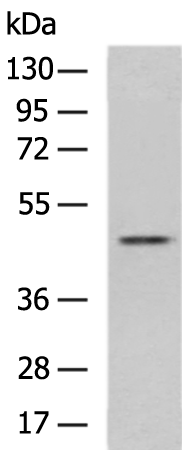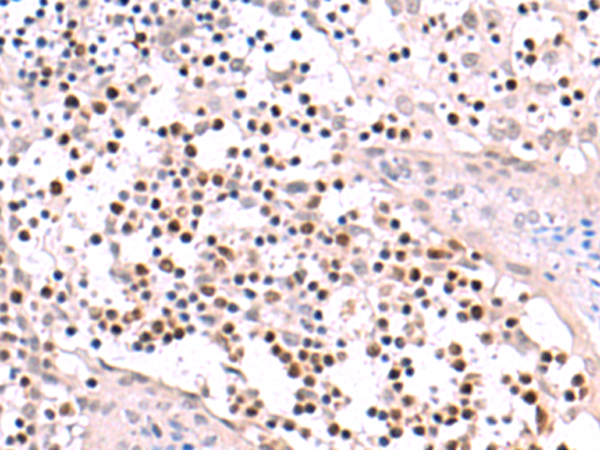

| WB | 咨询技术 | Human,Mouse,Rat |
| IF | 咨询技术 | Human,Mouse,Rat |
| IHC | 1/25-1/100 | Human,Mouse,Rat |
| ICC | 技术咨询 | Human,Mouse,Rat |
| FCM | 咨询技术 | Human,Mouse,Rat |
| Elisa | 1/5000-1/10000 | Human,Mouse,Rat |
| Aliases | AML2; CBFA3; PEBP2aC |
| WB Predicted band size | 44 kDa |
| Host/Isotype | Rabbit IgG |
| Antibody Type | Primary antibody |
| Storage | Store at 4°C short term. Aliquot and store at -20°C long term. Avoid freeze/thaw cycles. |
| Species Reactivity | Human, Mouse |
| Immunogen | Synthetic peptide of human RUNX3 |
| Formulation | Purified antibody in PBS with 0.05% sodium azide and 50% glycerol. |
+ +
以下是关于RUNX3抗体的模拟参考文献示例(仅供格式参考,具体文献需自行验证):
---
1. **文献名称**: "RUNX3 suppresses gastric cancer progression by regulating cell apoptosis and metastasis"
**作者**: Li Q.L. et al.
**摘要**: 研究利用RUNX3抗体通过免疫组化分析发现,RUNX3在胃癌组织中表达显著下调,其缺失与患者预后不良相关,并通过调控下游靶基因抑制肿瘤细胞侵袭。
---
2. **文献名称**: "The role of RUNX3 in T-cell differentiation and autoimmune diseases"
**作者**: Ito K. et al.
**摘要**: 通过Western blot和流式细胞术结合RUNX3特异性抗体,揭示了RUNX3在调节CD8+ T细胞分化和抑制自身免疫反应中的关键作用。
---
3. **文献名称**: "Epigenetic silencing of RUNX3 in colorectal cancer via promoter hypermethylation"
**作者**: Subramaniam M.M. et al.
**摘要**: 使用RUNX3抗体进行免疫染色和ChIP实验,证实结直肠癌中RUNX3因启动子高甲基化而表达沉默,导致肿瘤抑制功能丧失。
---
4. **文献名称**: "Antibody-based detection of RUNX3 isoforms in lung adenocarcinoma"
**作者**: Kim H.R. et al.
**摘要**: 开发了一种特异性识别RUNX3不同剪接变体的抗体,并应用于肺癌组织芯片分析,发现RUNX3亚型表达差异与EGFR信号通路异常相关。
---
**注意**:以上为模拟示例,实际文献需通过PubMed/Google Scholar等平台检索(关键词:RUNX3 antibody, immunohistochemistry, cancer)。
RUNX3 antibodies are immunological tools designed to detect and study the RUNX3 protein, a member of the RUNX family of transcription factors (RUNX1. RUNX2. RUNX3). These proteins share a conserved Runt homology domain for DNA binding and heterodimerization with cofactor CBFβ. RUNX3 plays critical roles in development, cell differentiation, and tumor suppression, particularly in gastrointestinal and immune systems. It regulates TGF-β and Wnt signaling pathways, and its loss or inactivation is linked to gastric, colorectal, and lung cancers. In immunity, RUNX3 directs CD8+ T-cell lineage commitment and dendritic cell function.
Antibodies against RUNX3 enable researchers to investigate its expression patterns, subcellular localization (nuclear vs. cytoplasmic shifts correlate with cancer progression), and interactions via techniques like Western blotting, immunohistochemistry (IHC), immunofluorescence (IF), and chromatin immunoprecipitation (ChIP). Commercial RUNX3 antibodies are typically raised in rabbits or mice, targeting specific epitopes (e.g., N-terminal or C-terminal regions). Clone-specific variability exists, requiring validation for species reactivity (human, mouse, rat) and application compatibility. Challenges include distinguishing between RUNX family members due to structural similarities and detecting low-abundance isoforms. These reagents are vital for cancer biomarker studies, mechanistic research, and exploring therapeutic strategies targeting RUNX3-associated pathways. Recent studies also highlight its role in neuronal development and autoimmune diseases, expanding diagnostic potential.
×